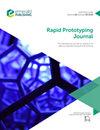A real-time approach for failure detection in material extrusion process based on artificial neural network
IF 3.6
4区 工程技术
Q1 ENGINEERING, MECHANICAL
引用次数: 0
Abstract
Purpose This paper aims to detect the printing failures (such as warpage and collapse) in material extrusion (MEX) process effectively and timely to reduce the waste of printing time, energy and material. Design/methodology/approach The approach is designed based on the frequently observed fact that printing failures are accompanied by abnormal material phenomena occurring close to the nozzle. To effectively and timely capture the phenomena near the nozzle, a camera is delicately installed on a typical MEX printer. Then, aided by the captured phenomena (images), a smart printing failure predictor is built based on the artificial neural network (ANN). Finally, based on the predictor, the printing failures, as well as their types, can be effectively detected from the images captured by the camera in real-time. Findings Experiments show that printing failures can be detected timely with an accuracy of more than 98% on average. Comparisons in methodology demonstrate that this approach has advantages in real-time printing failure detection in MEX. Originality/value A novel real-time approach for failure detection is proposed based on ANN. The following characteristics make the approach have a great potential to be implemented easily and widely: (1) the scheme designed to capture the phenomena near the nozzle is simple, low-cost, and effective; and (2) the predictor can be conveniently extended to detect more types of failures by using more abnormal material phenomena that are occurring close to the nozzle.基于人工神经网络的材料挤压过程故障实时检测方法
目的有效、及时地检测材料挤出过程中的印刷故障(如翘曲、塌陷),减少印刷时间、精力和材料的浪费。设计/方法/方法该方法是基于经常观察到的事实设计的,即打印故障伴随着喷嘴附近发生的异常材料现象。为了有效及时地捕捉喷嘴附近的现象,在典型的MEX打印机上精心安装了一台相机。然后,在捕捉到的现象(图像)的帮助下,基于人工神经网络(ANN)建立了智能打印故障预测器。最后,基于预测器,可以从相机实时拍摄的图像中有效地检测打印故障及其类型。实验表明,打印故障可以及时检测,平均准确率超过98%。方法论上的比较表明,该方法在MEX.Originality/value中的实时打印故障检测中具有优势。提出了一种基于人工神经网络的实时故障检测新方法。该方法具有以下特点,具有易于广泛实现的巨大潜力:(1)设计用于捕捉喷嘴附近现象的方案简单,低成本、有效;以及(2)通过使用在喷嘴附近发生的更多异常材料现象,可以方便地扩展预测器以检测更多类型的故障。
本文章由计算机程序翻译,如有差异,请以英文原文为准。
求助全文
约1分钟内获得全文
求助全文
来源期刊

Rapid Prototyping Journal
工程技术-材料科学:综合
CiteScore
8.30
自引率
10.30%
发文量
137
审稿时长
4.6 months
期刊介绍:
Rapid Prototyping Journal concentrates on development in a manufacturing environment but covers applications in other areas, such as medicine and construction. All papers published in this field are scattered over a wide range of international publications, none of which actually specializes in this particular discipline, this journal is a vital resource for anyone involved in additive manufacturing. It draws together important refereed papers on all aspects of AM from distinguished sources all over the world, to give a truly international perspective on this dynamic and exciting area.
-Benchmarking – certification and qualification in AM-
Mass customisation in AM-
Design for AM-
Materials aspects-
Reviews of processes/applications-
CAD and other software aspects-
Enhancement of existing processes-
Integration with design process-
Management implications-
New AM processes-
Novel applications of AM parts-
AM for tooling-
Medical applications-
Reverse engineering in relation to AM-
Additive & Subtractive hybrid manufacturing-
Industrialisation
 求助内容:
求助内容: 应助结果提醒方式:
应助结果提醒方式:


